ONOS - multiple instance setting(Distributed SDN Controller)
3 likes2,636 views
ONOS - Distributed SDN Controller multiple instance configuration and setting Mininet test
1 of 31
Downloaded 93 times
![ONOS SDN Controller
???? ?? ? SDN ????
Mobile Convergence Lab, Computer Engineering,
Kyung Hee University
Sangyun Han
Email : sangyun0628@khu.ac.kr
SDN/NFV ??, ??, ????
[ONOS ?? ???? ?? ? ???]](https://image.slidesharecdn.com/3-160523115712/85/ONOS-multiple-instance-setting-Distributed-SDN-Controller-1-320.jpg)
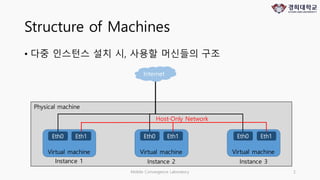
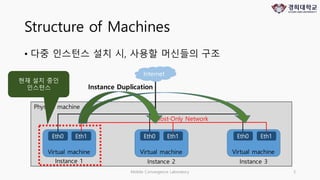
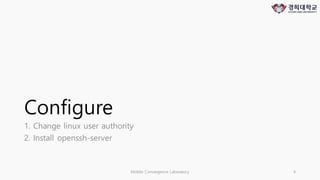
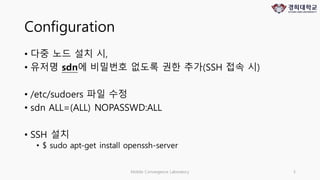
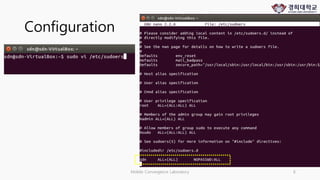
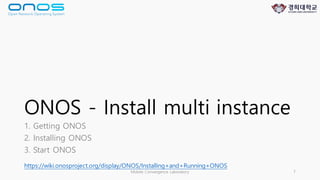
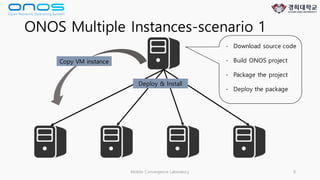
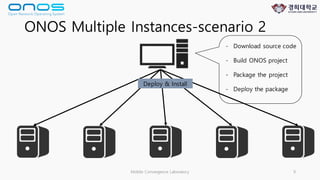

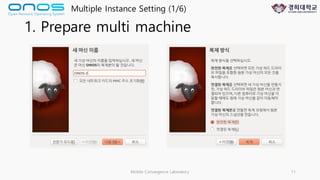

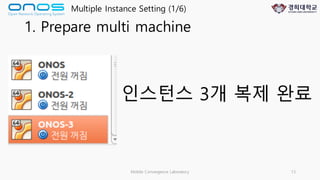
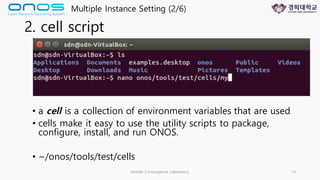
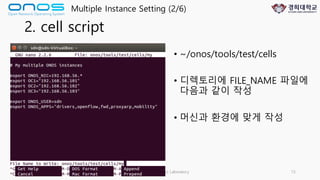

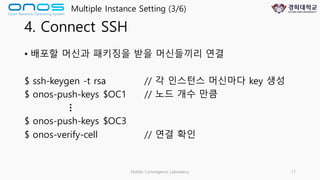
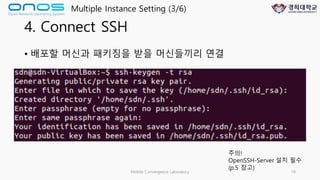
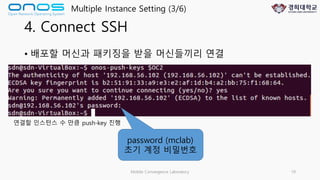
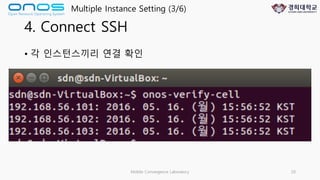
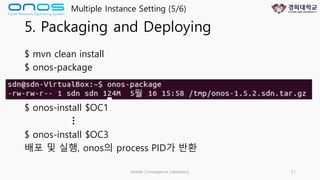
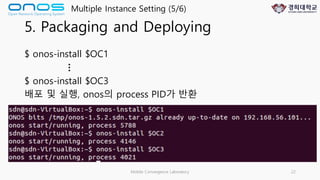
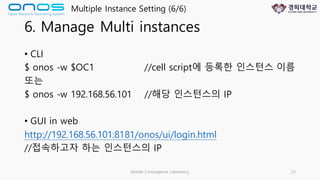
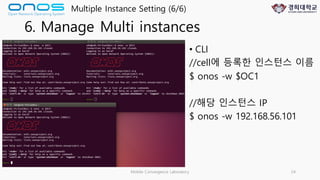
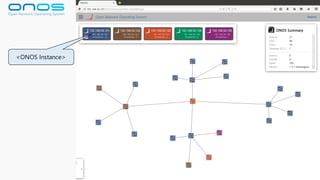
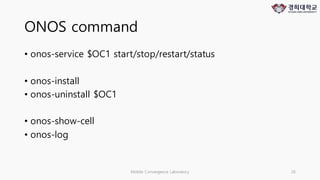
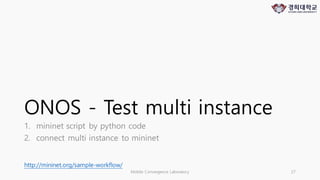
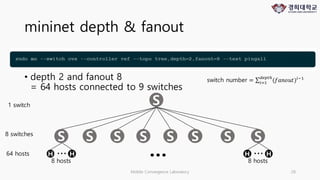
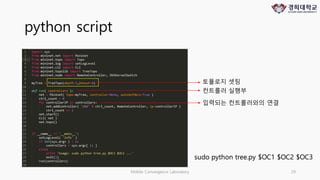
![tree.py code
import sys
from mininet.net import Mininet
from mininet.topo import Topo
from mininet.log import setLogLevel
from mininet.cli import CLI
from mininet.topolib import TreeTopo
from mininet.node import RemoteController, OVSKernelSwitch
myTree = TreeTopo(depth=3,fanout=4)
def run( controllers ):
net = Mininet( topo=myTree, controller=None, autoSetMacs=True )
ctrl_count = 0
for controllerIP in controllers:
net.addController( 'c%d' % ctrl_count, RemoteController, ip=controllerIP )
ctrl_count += 1
net.start()
CLI( net )
net.topo()
if __name__ == '__main__':
setLogLevel( 'info' )
if len(sys.argv ) > 1:
controllers = sys.argv[ 1: ]
else:
print 'Usage: sudo python tree.py '
exit(1)
run(controllers)
Mobile Convergence Laboratory 30
for copy & paste](https://image.slidesharecdn.com/3-160523115712/85/ONOS-multiple-instance-setting-Distributed-SDN-Controller-30-320.jpg)

Recommended


Rapport dˇŻinstallation dˇŻun serveur de messagerie avec le Webmail RoundcubeBalla Moussa Doumbouya
?
Ce projet vous permet d'installer et configurer un sserveur de messagerie avec le Webmail RoundcubeSelf Healing Capabilities of Domino 10



Self Healing Capabilities of Domino 10Kim Greene Consulting, Inc.
?
Domino 10 has some amazing self-healing capabilities that are going to make every adminˇŻs life much easier. Learn how automatic cluster database symmetry works to ensure both NSFs and DAOS content are kept in sync across cluster mates. Understand how the repair engine remedies any missing databases or NLOs, rebuilds full text indexes, and detects and repairs corrupt NSFs and NLOs. You will also learn how to use the new commands to manually invoke corruption repair and how the new replica synchronization tool and replication currency monitoring work. Get the ins and outs of the functionality of automatic hot view updating and how to setup deletion logging so you know who/what deleted a document. 

LˇŻ Administration des R¨¦seaux en PratiqueAmadou Dia
?
Mise en ?uvre dˇŻun r¨¦seau comportant les services DNS, DHCP, Messagerie, SAMBA, LDAP, Radius, Kerberos et pour finir le Nat avec iptables

Reporte de pr¨˘cticas cap¨Ştulo 2 ciscoJos¨¦ Alexis Cruz Solar
?
Este documento resume tres pr¨˘cticas realizadas sobre redes de computadoras. La primera involucra el uso de herramientas de rastreo de rutas como tracert y NeoTrace para visualizar la ruta entre un origen y destino. La segunda describe la construcci¨®n de una red punto a punto y la identificaci¨®n de cables. La tercera involucra la compleci¨®n de una topolog¨Şa en Packet Tracer, el env¨Şo de paquetes entre dispositivos y el an¨˘lisis de paquetes en modo de simulaci¨®n.Free CCNA workbook by networkers home pdf



Free CCNA workbook by networkers home pdfNetworkershome
?
ccna workbook and lab manual by NETWORKERS HOME. NETWORKERS HOME understand the importance of CCNA workbook when it comes Cisco certification which is why we offered free CCNA workbook.BusyBox for Embedded Linux



BusyBox for Embedded LinuxEmertxe Information Technologies Pvt Ltd
?
Often called as the Swiss Army Knife of Embedded Linux, BusyBox combines tiny versions of many common UNIX utilities into a single small executable. It provides replacements for most of the utilities you usually find in GNU fileutils, shellutils, etc. It is written with size-optimization
and limited resources in mind. Here is a presentation that details about BusyBox.10 Tips for AIX Security



10 Tips for AIX SecurityHelpSystems
?
In this PowerPoint, learn how a security policy can be your first line of defense. Servers running AIX and other operating systems are frequent targets of cyberattacks, according to the Data Breach Investigations Report. From DoS attacks to malware, attackers have a variety of strategies at their disposal. Having a security policy in place makes it easier to ensure you have appropriate controls in place to protect mission-critical data.Introduction 2 linux



Introduction 2 linuxPapu Kumar
?
What is Linux?
Command-line Interface, Shell & BASH
Popular commands
File Permissions and Owners
Installing programs
Piping and Scripting
Variables
Common applications in bioinformatics
Conclusion

Expose de sur le systeme d'exploitation linuxStephen Salama
?
Survol sur le syst¨¨me d'exploitation Linux

Rapport installation round cube centos 7Mame Cheikh Ibra Niang
?
Installation de la messagerie sous linux avec postfix,dovecot et le webmail Roundcube ous centos 7Network Programming: Data Plane Development Kit (DPDK)



Network Programming: Data Plane Development Kit (DPDK)Andriy Berestovskyy
?
This presentation introduces Data Plane Development Kit overview and basics. It is a part of a Network Programming Series.
First, the presentation focuses on the network performance challenges on the modern systems by comparing modern CPUs with modern 10 Gbps ethernet links. Then it touches memory hierarchy and kernel bottlenecks.
The following part explains the main DPDK techniques, like polling, bursts, hugepages and multicore processing.
DPDK overview explains how is the DPDK application is being initialized and run, touches lockless queues (rte_ring), memory pools (rte_mempool), memory buffers (rte_mbuf), hashes (rte_hash), cuckoo hashing, longest prefix match library (rte_lpm), poll mode drivers (PMDs) and kernel NIC interface (KNI).
At the end, there are few DPDK performance tips.
Tags: access time, burst, cache, dpdk, driver, ethernet, hub, hugepage, ip, kernel, lcore, linux, memory, pmd, polling, rss, softswitch, switch, userspace, xeonONOS SDN Controller - Clustering Tests & Experiments 



ONOS SDN Controller - Clustering Tests & Experiments Eueung Mulyana
?
The document describes setting up an ONOS cluster experiment including the target machines, management VM, and manual ONOS installation process. It discusses preparing the target machines by installing dependencies, Java, and manually extracting the ONOS binary. It also covers preparing the management VM by cloning the ONOS source code from Gerrit, checking out the 1.12.0 version, building ONOS, and installing additional tools for management.

COUPLAGE ENTRE Asterisk et OpenIMSCoreAbdou Lahad SYLLA
?
LˇŻobjectif de ce projet cˇŻest de mettre en place un trunk entre un serveur Asterisk et un serveur OpenIMS Core afin de permettre aux utilisateurs des deux services de sˇŻappeler mutuellement.Analysis of Open-Source Drivers for IEEE 802.11 WLANs



Analysis of Open-Source Drivers for IEEE 802.11 WLANsDanh Nguyen
?
This document provides an overview of open-source 802.11 wireless device drivers, including how they work with the Linux kernel network stack. It describes the central network device data structure, socket buffers for packet transmission, and how the mac80211 framework and SoftMAC drivers like Ath9k interact. Specific driver functions like transmission paths and configurable parameters are outlined. An example of spectral scanning code for dynamic frequency selection is also summarized.PLNOG15: Practical deployments of Kea, a high performance scalable DHCP - Tom...



PLNOG15: Practical deployments of Kea, a high performance scalable DHCP - Tom...PROIDEA
?
This document discusses Kea, an open source DHCP server from ISC. It provides high-level summaries of Kea's design, features, and deployments. Kea was designed for high performance, modularity, and scalability. Notable deployments include a large ISP serving over 2 million users and Facebook using Kea in their datacenters for bare metal provisioning. Kea provides advantages like failure resilience, rapid configuration updates, and metrics collection.

Mise en place d'un syst¨¨me de messagerie sous debian avec: postfix, dovecot, ...Manass¨¦ Achim kpaya
?
administrationPacket flow on openstack



Packet flow on openstackAchhar Kalia
?
The document describes the packet flow for a compute node in OpenStack. It outlines 7 steps for the packet flow within the compute node, including the instance tap interface forwarding to the Linux bridge, security group rules handling on the bridge, and tagging by Open vSwitch bridges. It then describes 4 steps for the physical network infrastructure, including VLAN tag handling by switches and routing by a router between the provider and external networks.TCPdump-Wireshark



TCPdump-WiresharkHarsh Singh
?
The document provides an introduction to TCPdump and Wireshark, including how to install and use TCPdump on Linux, the definition and features of Wireshark, and a comparison of TCPdump and Wireshark. Key points covered include how to install TCPdump using synaptic packet manager or through the terminal, commands to use TCPdump, what Wireshark is used for including network troubleshooting and analysis, and advantages of Wireshark like its GUI interface and filtering options over TCPdump.Linux Booting Steps



Linux Booting StepsAnando Kumar Paul
?
The Linux booting process involves multiple stages:
1) The BIOS loads the first stage boot loader from the MBR which finds and loads the second stage boot loader.
2) The second stage boot loader loads the Linux kernel and initial RAM disk. It then passes control to the kernel.
3) The kernel initializes hardware, mounts the root filesystem, and loads the init process to perform further system initialization.P4, EPBF, and Linux TC Offload



P4, EPBF, and Linux TC OffloadOpen-NFP
?
The webinar discussed accelerating P4 and eBPF programs on Netronome SmartNIC hardware. It covered the Linux kernel infrastructure like TC and XDP that supports offloading eBPF programs. It also explained how the NFP architecture is optimized for network flow processing with its multi-core design and memory hierarchy. The webinar demonstrated how eBPF programs can be translated to run efficiently on the NFP hardware by handling maps and applying optimizations.ÓĂRaspberry Pi ŚWLinux I2C Driver



ÓĂRaspberry Pi ŚWLinux I2C Driver°¬ĺŤżĆĽĽ
?
ÓĂRaspberry Pi ŚWLinux I2C Driver
http://www.ittraining.com.tw/ittraining/course/embedded/devicedriver


Tutoriel : Apprendre ¨¤ configurer et g¨¦rer un serveur Web sous Windows Server...Christophe Lauer
?
Tutoriel pas ¨¤ pas : Tutoriel : Apprendre ¨¤ installer, configurer, s¨¦curiser et g¨¦rer un serveur Web sous Windows Server 2008 R2

Firewall - IPCopFaniMR
?
IPCop es una distribuci¨®n Linux que implementa un cortafuegos (firewall) y proporciona una interfaz web de administraci¨®n. Originalmente naci¨® como una extensi¨®n de SmoothWall y tiene como objetivos ser un cortafuegos sencillo para usuarios dom¨¦sticos o peque?as empresas, administrado a trav¨¦s de una interfaz web con funcionalidades b¨˘sicas y avanzadas. IPCop se instala en una computadora con al menos dos tarjetas de red y 512 MB de RAM y proporciona funciones como filtrado de paquetes, asignaci¨®n de ancho de

Escaneo de puertos clase 2 complemento b 28 02-13Tensor
?
El documento describe diferentes t¨¦cnicas para escanear puertos, incluyendo TCP Connect, TCP SYN, TCP FIN, UDP scan y ACK scan. Explica c¨®mo funciona cada t¨¦cnica, sus ventajas e inconvenientes, y c¨®mo invocarlos con la herramienta Nmap. El objetivo es comprender las distintas formas de escanear puertos y los resultados que se pueden obtener.IT Essentials (Version 7.0) - ITE Chapter 12 Exam Answers



IT Essentials (Version 7.0) - ITE Chapter 12 Exam AnswersITExamAnswers.net
?
This document provides answers to exam questions about mobile device operating systems, security features, and networking. It includes 15 multiple choice questions about topics like:
- Location data sources used by locator apps
- Differences between iOS and Android
- Purposes of passcode locks on mobile devices
- Commands used to backup and store files in Linux
- Methods for removing restrictions from mobile OSs like rooting and jailbreaking
- Safe sources for downloading Android apps like Google PlayISAM ALU 7360 5520_ihub_turn_up_procedure



ISAM ALU 7360 5520_ihub_turn_up_procedureWahyu Nasution
?
This document provides instructions for configuring and turning up a new Alcatel-Lucent ISAM. It describes how to initially log in to the ISAM, configure the IP address and network port, set up the management VLAN and interface. It also covers configuring SNMP management between the ISAM and AMS. Standard procedures and alternative scenarios like configuring a Link Aggregation Group are presented.Linux Kernel Overview



Linux Kernel OverviewAnil Kumar Pugalia
?
The document provides an overview of the Linux kernel, including its architecture, startup process, functionality, configuration, and compilation. It discusses the differences between micro and monolithic kernels. It also explains the Linux kernel architecture with user space and kernel space separated by a system call interface. Key aspects covered include process management, memory management, device management, and the kernel build system.Operating systems linux



Operating systems linuxwilliam_morg
?
The document provides an overview of the Linux operating system, including its origins, capabilities, and essential components. It discusses how Linux began as a hobby for Linus Torvalds in 1991 and has since grown to power servers, supercomputers, and other devices. The document also summarizes that Linux is an open-source, customizable operating system made up of a kernel, operating system, environments, applications, and distributions. It is freely available and developed collaboratively by its user community.ONOS - setting, configuration, installation, and test



ONOS - setting, configuration, installation, and testsangyun han
?
ONOS single instance setting.
ONOS testing by mininet and pi stack switch(Open vSwitch)NODE.JS ??? ?? ?? ?? ???, real-time ?????? ????



NODE.JS ??? ?? ?? ?? ???, real-time ?????? ????John Kim
?
NODE.JS ??? ?? ?? ??
???, real-time ?????? ????
http://www.microsoftvirtualacademy.com/training-courses/node-js-on-cloudMore Related Content
What's hot (20)


Expose de sur le systeme d'exploitation linuxStephen Salama
?
Survol sur le syst¨¨me d'exploitation Linux

Rapport installation round cube centos 7Mame Cheikh Ibra Niang
?
Installation de la messagerie sous linux avec postfix,dovecot et le webmail Roundcube ous centos 7Network Programming: Data Plane Development Kit (DPDK)



Network Programming: Data Plane Development Kit (DPDK)Andriy Berestovskyy
?
This presentation introduces Data Plane Development Kit overview and basics. It is a part of a Network Programming Series.
First, the presentation focuses on the network performance challenges on the modern systems by comparing modern CPUs with modern 10 Gbps ethernet links. Then it touches memory hierarchy and kernel bottlenecks.
The following part explains the main DPDK techniques, like polling, bursts, hugepages and multicore processing.
DPDK overview explains how is the DPDK application is being initialized and run, touches lockless queues (rte_ring), memory pools (rte_mempool), memory buffers (rte_mbuf), hashes (rte_hash), cuckoo hashing, longest prefix match library (rte_lpm), poll mode drivers (PMDs) and kernel NIC interface (KNI).
At the end, there are few DPDK performance tips.
Tags: access time, burst, cache, dpdk, driver, ethernet, hub, hugepage, ip, kernel, lcore, linux, memory, pmd, polling, rss, softswitch, switch, userspace, xeonONOS SDN Controller - Clustering Tests & Experiments 



ONOS SDN Controller - Clustering Tests & Experiments Eueung Mulyana
?
The document describes setting up an ONOS cluster experiment including the target machines, management VM, and manual ONOS installation process. It discusses preparing the target machines by installing dependencies, Java, and manually extracting the ONOS binary. It also covers preparing the management VM by cloning the ONOS source code from Gerrit, checking out the 1.12.0 version, building ONOS, and installing additional tools for management.

COUPLAGE ENTRE Asterisk et OpenIMSCoreAbdou Lahad SYLLA
?
LˇŻobjectif de ce projet cˇŻest de mettre en place un trunk entre un serveur Asterisk et un serveur OpenIMS Core afin de permettre aux utilisateurs des deux services de sˇŻappeler mutuellement.Analysis of Open-Source Drivers for IEEE 802.11 WLANs



Analysis of Open-Source Drivers for IEEE 802.11 WLANsDanh Nguyen
?
This document provides an overview of open-source 802.11 wireless device drivers, including how they work with the Linux kernel network stack. It describes the central network device data structure, socket buffers for packet transmission, and how the mac80211 framework and SoftMAC drivers like Ath9k interact. Specific driver functions like transmission paths and configurable parameters are outlined. An example of spectral scanning code for dynamic frequency selection is also summarized.PLNOG15: Practical deployments of Kea, a high performance scalable DHCP - Tom...



PLNOG15: Practical deployments of Kea, a high performance scalable DHCP - Tom...PROIDEA
?
This document discusses Kea, an open source DHCP server from ISC. It provides high-level summaries of Kea's design, features, and deployments. Kea was designed for high performance, modularity, and scalability. Notable deployments include a large ISP serving over 2 million users and Facebook using Kea in their datacenters for bare metal provisioning. Kea provides advantages like failure resilience, rapid configuration updates, and metrics collection.

Mise en place d'un syst¨¨me de messagerie sous debian avec: postfix, dovecot, ...Manass¨¦ Achim kpaya
?
administrationPacket flow on openstack



Packet flow on openstackAchhar Kalia
?
The document describes the packet flow for a compute node in OpenStack. It outlines 7 steps for the packet flow within the compute node, including the instance tap interface forwarding to the Linux bridge, security group rules handling on the bridge, and tagging by Open vSwitch bridges. It then describes 4 steps for the physical network infrastructure, including VLAN tag handling by switches and routing by a router between the provider and external networks.TCPdump-Wireshark



TCPdump-WiresharkHarsh Singh
?
The document provides an introduction to TCPdump and Wireshark, including how to install and use TCPdump on Linux, the definition and features of Wireshark, and a comparison of TCPdump and Wireshark. Key points covered include how to install TCPdump using synaptic packet manager or through the terminal, commands to use TCPdump, what Wireshark is used for including network troubleshooting and analysis, and advantages of Wireshark like its GUI interface and filtering options over TCPdump.Linux Booting Steps



Linux Booting StepsAnando Kumar Paul
?
The Linux booting process involves multiple stages:
1) The BIOS loads the first stage boot loader from the MBR which finds and loads the second stage boot loader.
2) The second stage boot loader loads the Linux kernel and initial RAM disk. It then passes control to the kernel.
3) The kernel initializes hardware, mounts the root filesystem, and loads the init process to perform further system initialization.P4, EPBF, and Linux TC Offload



P4, EPBF, and Linux TC OffloadOpen-NFP
?
The webinar discussed accelerating P4 and eBPF programs on Netronome SmartNIC hardware. It covered the Linux kernel infrastructure like TC and XDP that supports offloading eBPF programs. It also explained how the NFP architecture is optimized for network flow processing with its multi-core design and memory hierarchy. The webinar demonstrated how eBPF programs can be translated to run efficiently on the NFP hardware by handling maps and applying optimizations.ÓĂRaspberry Pi ŚWLinux I2C Driver



ÓĂRaspberry Pi ŚWLinux I2C Driver°¬ĺŤżĆĽĽ
?
ÓĂRaspberry Pi ŚWLinux I2C Driver
http://www.ittraining.com.tw/ittraining/course/embedded/devicedriver


Tutoriel : Apprendre ¨¤ configurer et g¨¦rer un serveur Web sous Windows Server...Christophe Lauer
?
Tutoriel pas ¨¤ pas : Tutoriel : Apprendre ¨¤ installer, configurer, s¨¦curiser et g¨¦rer un serveur Web sous Windows Server 2008 R2

Firewall - IPCopFaniMR
?
IPCop es una distribuci¨®n Linux que implementa un cortafuegos (firewall) y proporciona una interfaz web de administraci¨®n. Originalmente naci¨® como una extensi¨®n de SmoothWall y tiene como objetivos ser un cortafuegos sencillo para usuarios dom¨¦sticos o peque?as empresas, administrado a trav¨¦s de una interfaz web con funcionalidades b¨˘sicas y avanzadas. IPCop se instala en una computadora con al menos dos tarjetas de red y 512 MB de RAM y proporciona funciones como filtrado de paquetes, asignaci¨®n de ancho de

Escaneo de puertos clase 2 complemento b 28 02-13Tensor
?
El documento describe diferentes t¨¦cnicas para escanear puertos, incluyendo TCP Connect, TCP SYN, TCP FIN, UDP scan y ACK scan. Explica c¨®mo funciona cada t¨¦cnica, sus ventajas e inconvenientes, y c¨®mo invocarlos con la herramienta Nmap. El objetivo es comprender las distintas formas de escanear puertos y los resultados que se pueden obtener.IT Essentials (Version 7.0) - ITE Chapter 12 Exam Answers



IT Essentials (Version 7.0) - ITE Chapter 12 Exam AnswersITExamAnswers.net
?
This document provides answers to exam questions about mobile device operating systems, security features, and networking. It includes 15 multiple choice questions about topics like:
- Location data sources used by locator apps
- Differences between iOS and Android
- Purposes of passcode locks on mobile devices
- Commands used to backup and store files in Linux
- Methods for removing restrictions from mobile OSs like rooting and jailbreaking
- Safe sources for downloading Android apps like Google PlayISAM ALU 7360 5520_ihub_turn_up_procedure



ISAM ALU 7360 5520_ihub_turn_up_procedureWahyu Nasution
?
This document provides instructions for configuring and turning up a new Alcatel-Lucent ISAM. It describes how to initially log in to the ISAM, configure the IP address and network port, set up the management VLAN and interface. It also covers configuring SNMP management between the ISAM and AMS. Standard procedures and alternative scenarios like configuring a Link Aggregation Group are presented.Linux Kernel Overview



Linux Kernel OverviewAnil Kumar Pugalia
?
The document provides an overview of the Linux kernel, including its architecture, startup process, functionality, configuration, and compilation. It discusses the differences between micro and monolithic kernels. It also explains the Linux kernel architecture with user space and kernel space separated by a system call interface. Key aspects covered include process management, memory management, device management, and the kernel build system.Operating systems linux



Operating systems linuxwilliam_morg
?
The document provides an overview of the Linux operating system, including its origins, capabilities, and essential components. It discusses how Linux began as a hobby for Linus Torvalds in 1991 and has since grown to power servers, supercomputers, and other devices. The document also summarizes that Linux is an open-source, customizable operating system made up of a kernel, operating system, environments, applications, and distributions. It is freely available and developed collaboratively by its user community.







Mise en place d'un syst¨¨me de messagerie sous debian avec: postfix, dovecot, ...Manass¨¦ Achim kpaya
?






Similar to ONOS - multiple instance setting(Distributed SDN Controller) (20)
ONOS - setting, configuration, installation, and test



ONOS - setting, configuration, installation, and testsangyun han
?
ONOS single instance setting.
ONOS testing by mininet and pi stack switch(Open vSwitch)NODE.JS ??? ?? ?? ?? ???, real-time ?????? ????



NODE.JS ??? ?? ?? ?? ???, real-time ?????? ????John Kim
?
NODE.JS ??? ?? ?? ??
???, real-time ?????? ????
http://www.microsoftvirtualacademy.com/training-courses/node-js-on-cloudAWS Summit Seoul 2015 - AWS? ?? ?? ??? ??



AWS Summit Seoul 2015 - AWS? ?? ?? ??? ??Amazon Web Services Korea
?
2015? 4? 21? ?? ????? ??? AWS Summit Seoul 2015? ??? ???? ??? ??? ???? ???? ????? ??? ?????.Build the OpenStack Cloud with Neutron Networing, IceHouse



Build the OpenStack Cloud with Neutron Networing, IceHousejieun kim
?
Build the OpenStack Cloud with Neutron Networing, IceHouseConfd, systemd, fleet? ??? ?????? ?? in CoreOS



Confd, systemd, fleet? ??? ?????? ?? in CoreOS?? ?
?
Confd, systemd, fleet? ??? ?????? ?? in CoreOS
Docker Seoul Meetup #2?? ??? ?????.
CoreOS?? confd? sidekick service? ??? ??? ??? ?? ?????.
http://www.youtube.com/watch?v=5ixJCM6pAcg
??? ?? ??? ? ???? :)Mcollective orchestration tool ??



Mcollective orchestration tool ???? ?
?
RabbitMQ/ActiveMQ ? ?? ??? ??? ????? ???? ??? ??? orchestration(command & control) ? ? ?? mcollective? ?? ?? ppt ?????. ??? ??? http://wiki.tunelinux.pe.kr/x/LQAy ? ????? ???.???? ??? ?? ??? ????(Kvm) ?? Provisioning 



???? ??? ?? ??? ????(Kvm) ?? Provisioning Ji-Woong Choi
?
TTA? KVM ?? ????? ??? ?? ?? ??? ???? ??? ?? ?????. ???????? ??? ???Paas? ?? ????? ???? ??? ??? ???? ???? ???? ???? ?? ???? ?????? ????? ???.?
??? ? hypervisor?? cloud ???? ?? ???? kvm? ???? ?? ??? ??? ???? ???? rhev? openstack? ?? ??? ????.?
??? ??? ??? ???? ???? ??? ?? ???? ??? ???? ???? ????, ?? ????? ??? ??? ??? ?? ???????.
??? ????????? ???? ???? ???? ?? ??????? ????? ???? ??? ansible provisioning ??? ?????. [OpenInfra Days Korea 2018] (Track 1) ???? ???? ??? ?? ?? ? ???? ??![[OpenInfra Days Korea 2018] (Track 1) ???? ???? ??? ?? ?? ? ???? ??](https://cdn.slidesharecdn.com/ss_thumbnails/14openstackpackagingstrategy-180704054102-thumbnail.jpg?width=560&fit=bounds)
![[OpenInfra Days Korea 2018] (Track 1) ???? ???? ??? ?? ?? ? ???? ??](https://cdn.slidesharecdn.com/ss_thumbnails/14openstackpackagingstrategy-180704054102-thumbnail.jpg?width=560&fit=bounds)
![[OpenInfra Days Korea 2018] (Track 1) ???? ???? ??? ?? ?? ? ???? ??](https://cdn.slidesharecdn.com/ss_thumbnails/14openstackpackagingstrategy-180704054102-thumbnail.jpg?width=560&fit=bounds)
![[OpenInfra Days Korea 2018] (Track 1) ???? ???? ??? ?? ?? ? ???? ??](https://cdn.slidesharecdn.com/ss_thumbnails/14openstackpackagingstrategy-180704054102-thumbnail.jpg?width=560&fit=bounds)
[OpenInfra Days Korea 2018] (Track 1) ???? ???? ??? ?? ?? ? ???? ??OpenStack Korea Community
?
- ???: ??????? ???
- ??: https://event.openinfradays.kr/2018/session1/track_1_3(OCI ????) cloud shell



(OCI ????) cloud shellJay Park
?
??? ??: https://www.youtube.com/watch?v=rImoxlfnAqg&list=PLdntWJk2tJPK9kMeQa5Ls-G5FlmPHEnUe&index=6Node.js ??



Node.js ??Han Jung Hyun
?
node.js ? ??? ?? ??? ????? ?? ???.
??? ???? ??? ??? ??? ?? ? ??? ?? ??? ????????.
?? ????? ??? ??? ??, express, heroku ??, ??? ??? ???????. Io t??? ??????????_????



Io t??? ??????????_????SangIn Choung
?
????+?????+????+?????? ??? IoT??
????? ?? ??? ???? ?? Mockito, PowerMock ??
??? ??? ????? ?????? ??? ??SDN???? ??_?????



SDN???? ??_?????ATTO Research
?
????? ?? ? ??? SDN???? ?????
? ?? ??? ?????? ?? ? ????.
**????? SNS**
Website: http://www.atto-research.com/
Facebook: https://www.facebook.com/attoresearch/
Youtube: www.youtube.com/channel/UC3y0LupaApOalX1qPYH_hAg??????? Node.js? Vert.x



??????? Node.js? Vert.xTerry Cho
?
node.js ? ???, ??, ?????
vert.x? ?? ??? ??? node.js? ??? ?? ? ??? ?? ??? ??K8s beginner 2_advanced_ep02_201904221130_post



K8s beginner 2_advanced_ep02_201904221130_postInho Kang
?
Kubernetes internal Series - Episode 2
Kubernetes Worker Node Component(Kubelet, kube-proxy, Container Runtime Interface) & Kubernetes Network[??? ???? ??? ????? ?????? Pub] 3.open shift ??![[??? ???? ??? ????? ?????? Pub] 3.open shift ??](https://cdn.slidesharecdn.com/ss_thumbnails/pub3-140818080510-phpapp02-thumbnail.jpg?width=560&fit=bounds)
![[??? ???? ??? ????? ?????? Pub] 3.open shift ??](https://cdn.slidesharecdn.com/ss_thumbnails/pub3-140818080510-phpapp02-thumbnail.jpg?width=560&fit=bounds)
![[??? ???? ??? ????? ?????? Pub] 3.open shift ??](https://cdn.slidesharecdn.com/ss_thumbnails/pub3-140818080510-phpapp02-thumbnail.jpg?width=560&fit=bounds)
![[??? ???? ??? ????? ?????? Pub] 3.open shift ??](https://cdn.slidesharecdn.com/ss_thumbnails/pub3-140818080510-phpapp02-thumbnail.jpg?width=560&fit=bounds)
[??? ???? ??? ????? ?????? Pub] 3.open shift ??Tommy Lee
?
[??? ???? ??? ????? ?????? Pub] 3.open shift ??More from sangyun han (15)
SDN, ONOS, and Network Virtualization



SDN, ONOS, and Network Virtualizationsangyun han
?
This document discusses SDN (Software-Defined Networking) and ONOS (Open Network Operating System). It provides an overview of SDN, describing it as managing and controlling networks through software and making networks programmable. It then introduces ONOS, an open-source SDN controller developed to be carrier-grade and support high availability, performance, and scalability. It discusses ONOS's architecture, key subsystems, and capabilities for network virtualization including topology, address, and control function virtualization and virtual network snapshotting.Introduce to OpenVirteX



Introduce to OpenVirteXsangyun han
?
This document describes OpenVirteX, a network virtualization platform that enables multiple virtual networks to run concurrently over a single physical network infrastructure. It allows each tenant to define their own virtual network topologies. OpenVirteX decouples the physical and virtual networks and provides isolation between tenant traffic. It performs functions like topology virtualization, address space virtualization, and control function virtualization to manage the virtual networks. OpenVirteX also enables networks to be reconfigured at runtime and automatically recovers from physical network failures.XOS in open CORD project



XOS in open CORD projectsangyun han
?
This document discusses XOS and its role in OpenCORD. It describes how XOS uses a synchronizer to manage state changes to data models and synchronize them with OpenStack. Core components of OpenCORD include OpenStack, ONOS, XOS, and OCP. OpenCORD projects on GitHub include platform installation tools, XOS, MaaS, and services like AAA and Voltha. XOS assembles services using separate containers for the database, webserver, and synchronizer. TOSCA is used to describe application topologies and orchestrate operations across cloud providers.Introduction to CORD project



Introduction to CORD projectsangyun han
?
This document discusses CORD (Central Office Re-architecture as a DC) and its components. CORD combines SDN, NFV and cloud technologies to deliver services for telecommunications providers using open source software and commodity hardware. It discusses the requirements and types of CORD (M-CORD for mobile, E-CORD for enterprise, R-CORD for residential services). The core components that make up CORD are OpenStack for infrastructure, ONOS for control, and XOS as the service controller. XOS assembles and orchestrates the virtual network functions and services on top of the infrastructure and control layers.Introduction of ONOS and core technology



Introduction of ONOS and core technologysangyun han
?
This document provides an overview of ONOS (Open Network Operating System) including:
- ONOS is an open-source SDN controller created by ON.LAB to provide carriers with an SDN/NFV solution.
- It aims to be carrier-grade with high availability, scalability, and performance through a distributed architecture.
- ONOS uses southbound protocols like OpenFlow and Netconf to configure network elements while providing northbound APIs and applications.ONOS? Raspberry Pi ?? ???? SDN ?? ?? ??? ?? ??



ONOS? Raspberry Pi ?? ???? SDN ?? ?? ??? ?? ??sangyun han
?
The document provides information about setting up an SDN testbed using ONOS and Raspberry Pi. It introduces ONOS, an open source SDN operating system, and provides details on installing and running a single ONOS instance. It also covers setting up and managing multiple ONOS instances in a distributed deployment. Finally, it introduces OpenVirteX, a network virtualization platform, and provides an overview of its key features and the installation process.RAFT Consensus Algorithm



RAFT Consensus Algorithmsangyun han
?
The document discusses the RAFT consensus algorithm and the Copycat framework. It provides an overview of RAFT and how it uses a replicated state machine approach with log replication to achieve consensus. Key aspects of RAFT include leader election, log replication using append entries RPC calls, and three states that nodes can be in: follower, candidate, or leader. It also describes how Copycat is an implementation of RAFT that adds features like passive followers that replicate logs asynchronously using a gossip protocol for improved scalability.Hazelcast ??



Hazelcast ??sangyun han
?
Open Source IMDG(In-Memory Data Grid)? Hazelcast? ?? ??
Introduction about Open Source IMDG called HazelcastImplementing SDN Testbed(ONOS & OpenVirteX)



Implementing SDN Testbed(ONOS & OpenVirteX)sangyun han
?
SDN ????? ??
Build SDN testbed using Raspberry Pi
- SDN controller : ONOS
- Network Hypervisor : OpenVirteX
- OpenFlow Switch : Raspberry Pi2ONOS - multiple instance setting(Distributed SDN Controller)
- 1. ONOS SDN Controller ???? ?? ? SDN ???? Mobile Convergence Lab, Computer Engineering, Kyung Hee University Sangyun Han Email : sangyun0628@khu.ac.kr SDN/NFV ??, ??, ???? [ONOS ?? ???? ?? ? ???]
- 2. Structure of Machines ? ?? ???? ?? ?, ??? ???? ?? Mobile Convergence Laboratory 2 Internet Physical machine Virtual machine Virtual machine Virtual machine Instance 1 Instance 2 Instance 3 Eth0 Eth1 Eth0 Eth1 Eth0 Eth1 Host-Only Network
- 3. Structure of Machines ? ?? ???? ?? ?, ??? ???? ?? Mobile Convergence Laboratory 3 Internet Physical machine Virtual machine Virtual machine Virtual machine Instance 1 Instance 2 Instance 3 Eth0 Eth1 Eth0 Eth1 Eth0 Eth1 Host-Only Network ?? ?? ?? ???? Instance Duplication
- 4. Configure 1. Change linux user authority 2. Install openssh-server Mobile Convergence Laboratory 4
- 5. Configuration ? ?? ?? ?? ?, ? ??? sdn? ???? ??? ?? ??(SSH ?? ?) ? /etc/sudoers ?? ?? ? sdn ALL=(ALL) NOPASSWD:ALL ? SSH ?? ? $ sudo apt-get install openssh-server Mobile Convergence Laboratory 5
- 7. ONOS - Install multi instance 1. Getting ONOS 2. Installing ONOS 3. Start ONOS Mobile Convergence Laboratory 7 https://wiki.onosproject.org/display/ONOS/Installing+and+Running+ONOS
- 8. ONOS Multiple Instances-scenario 1 Mobile Convergence Laboratory 8 - Download source code - Build ONOS project - Package the project - Deploy the package Deploy & Install Copy VM instance
- 9. ONOS Multiple Instances-scenario 2 Mobile Convergence Laboratory 9 - Download source code - Build ONOS project - Package the project - Deploy the package Deploy & Install
- 10. 1. Prepare multi machine ? ?? ?? or ?? ?? ? ??? ??? ??( ˇß RAFT algorithm for distributed clustering) ? ?? ????? Java ?? ? ?? ??(1,2), ?? ??(4,5), ?? ??(7) ?? ? ?? ????? ??? ?? (??! MAC ?? ?? ??) Mobile Convergence Laboratory 10 Multiple Instance Setting (1/6)
- 11. 1. Prepare multi machine Mobile Convergence Laboratory 11 Multiple Instance Setting (1/6)
- 12. ??! Mobile Convergence Laboratory 12 ?? ??
- 13. 1. Prepare multi machine Mobile Convergence Laboratory 13 Multiple Instance Setting (1/6) ???? 3? ?? ??
- 14. 2. cell script Mobile Convergence Laboratory 14 Multiple Instance Setting (2/6) ? a cell is a collection of environment variables that are used ? cells make it easy to use the utility scripts to package, configure, install, and run ONOS. ? ~/onos/tools/test/cells
- 15. 2. cell script Mobile Convergence Laboratory 15 Multiple Instance Setting (2/6) ? ~/onos/tools/test/cells ? ????? FILE_NAME ??? ??? ?? ?? ? ??? ??? ?? ??
- 16. 3. Define control plane ? cell ???? ??? ????? ?? ??? ?? ?? $ cell FILE_NAME Mobile Convergence Laboratory 16 Multiple Instance Setting (4/6)
- 17. 4. Connect SSH ? ??? ??? ???? ?? ????? ?? $ ssh-keygen -t rsa // ? ???? ???? key ?? $ onos-push-keys $OC1 // ?? ?? ?? $ onos-push-keys $OC3 $ onos-verify-cell // ?? ?? Mobile Convergence Laboratory 17 Multiple Instance Setting (3/6) ˇ
- 18. 4. Connect SSH ? ??? ??? ???? ?? ????? ?? Mobile Convergence Laboratory 18 Multiple Instance Setting (3/6) ??! OpenSSH-Server ?? ?? (p.5 ??)
- 19. 4. Connect SSH ? ??? ??? ???? ?? ????? ?? Mobile Convergence Laboratory 19 Multiple Instance Setting (3/6) ??? ???? ? ?? push-key ?? password (mclab) ?? ?? ????
- 20. 4. Connect SSH ? ? ?????? ?? ?? Mobile Convergence Laboratory 20 Multiple Instance Setting (3/6)
- 21. 5. Packaging and Deploying $ mvn clean install $ onos-package $ onos-install $OC1 $ onos-install $OC3 ?? ? ??, onos? process PID? ?? Mobile Convergence Laboratory 21 Multiple Instance Setting (5/6) ˇ
- 22. 5. Packaging and Deploying $ onos-install $OC1 $ onos-install $OC3 ?? ? ??, onos? process PID? ?? Mobile Convergence Laboratory 22 Multiple Instance Setting (5/6) ˇ
- 23. 6. Manage Multi instances ? CLI $ onos -w $OC1 //cell script? ??? ???? ?? ?? $ onos -w 192.168.56.101 //?? ????? IP ? GUI in web http://192.168.56.101:8181/onos/ui/login.html //????? ?? ????? IP Mobile Convergence Laboratory 23 Multiple Instance Setting (6/6)
- 24. 6. Manage Multi instances ? CLI //cell? ??? ???? ?? $ onos -w $OC1 //?? ???? IP $ onos -w 192.168.56.101 Mobile Convergence Laboratory 24 Multiple Instance Setting (6/6)
- 25. Mobile Convergence Laboratory 25 <ONOS Instance>
- 26. ONOS command ? onos-service $OC1 start/stop/restart/status ? onos-install ? onos-uninstall $OC1 ? onos-show-cell ? onos-log Mobile Convergence Laboratory 26
- 27. ONOS - Test multi instance 1. mininet script by python code 2. connect multi instance to mininet Mobile Convergence Laboratory 27 http://mininet.org/sample-workflow/
- 28. mininet depth & fanout ? depth 2 and fanout 8 = 64 hosts connected to 9 switches Mobile Convergence Laboratory 28 S S SS S SS SS H Hˇ 8 hosts H Hˇ 8 hosts ˇ64 hosts 8 switches 1 switch switch number = ˇĆ (??????)+,-./012 +3-
- 29. python script Mobile Convergence Laboratory 29 ???? ?????? ?? sudo python tree.py $OC1 $OC2 $OC3 ???? ??? ???? ??
- 30. tree.py code import sys from mininet.net import Mininet from mininet.topo import Topo from mininet.log import setLogLevel from mininet.cli import CLI from mininet.topolib import TreeTopo from mininet.node import RemoteController, OVSKernelSwitch myTree = TreeTopo(depth=3,fanout=4) def run( controllers ): net = Mininet( topo=myTree, controller=None, autoSetMacs=True ) ctrl_count = 0 for controllerIP in controllers: net.addController( 'c%d' % ctrl_count, RemoteController, ip=controllerIP ) ctrl_count += 1 net.start() CLI( net ) net.topo() if __name__ == '__main__': setLogLevel( 'info' ) if len(sys.argv ) > 1: controllers = sys.argv[ 1: ] else: print 'Usage: sudo python tree.py ' exit(1) run(controllers) Mobile Convergence Laboratory 30 for copy & paste




![[231]???????????????????????????????????????? ????????](https://cdn.slidesharecdn.com/ss_thumbnails/231-161025004555-thumbnail.jpg?width=560&fit=bounds)
![[Ansible] Solution Guide V0.4_20181204.pdf](https://cdn.slidesharecdn.com/ss_thumbnails/ansiblesolutionguidev0-240329014429-50cc2cc4-thumbnail.jpg?width=560&fit=bounds)



![[SoftCon]SDN/IoT ??? Testbed](https://cdn.slidesharecdn.com/ss_thumbnails/softcon-151119130927-lva1-app6892-thumbnail.jpg?width=560&fit=bounds)

